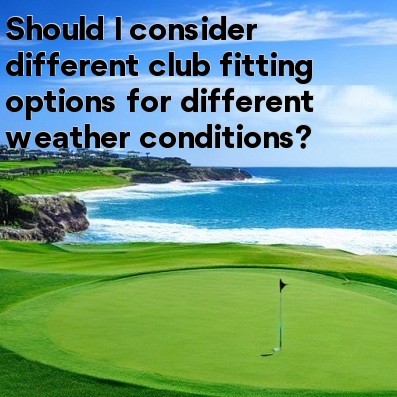
Should I Consider Different Club Fitting Options for Different Weather Conditions?
Golf is a game greatly affected by external factors, and weather conditions play a significant role in determining how well the game goes. Many golfers focus on club selection and technique, but often overlook the importance of club fitting for different weather conditions. In this article, we will explore why considering different club fitting options for various weather conditions can have a positive impact on your game.
1. Temperature:
When it comes to temperature, both hot and cold conditions can have an effect on your golf game. In hotter weather, the golf ball tends to fly farther due to the air density being lower. To counter this, using a club with less loft can help bring the ball flight down and maintain control. On the other hand, in colder weather, the golf ball tends to lose distance and feel harder. Using a club with extra loft can help increase launch angle and counteract the overall decrease in ball flight.
2. Humidity:
The level of humidity in the air can significantly affect the distance a golf ball travels. In high humidity conditions, the air is denser, making it harder for the ball to travel through it. For such conditions, using a club with less loft can help reduce spin and increase distance. Conversely, in low humidity conditions, the air is drier, allowing the golf ball to travel farther. Using a club with more loft can maximize this advantage by adding more lift to the shot.
3. Wind:
Wind is an ever-present factor on the golf course, and it can have a dramatic impact on shot accuracy and distance. When playing in windy conditions, it is crucial to choose the right club to combat the wind's strength and direction. Generally, using a club with more loft can help keep the ball flight lower and more controlled. Conversely, in downwind situations, a club with less loft can help increase distance by taking advantage of the tailwind.
4. Rain:
Golfing in the rain presents an entirely different set of challenges. The wetness can affect the club's grip on the ball, leading to reduced spin and control. Using a club with a higher degree of loft can help increase spin and improve traction between the ball and the clubface. Additionally, during wet conditions, the fairways may become softer, reducing roll. Adjusting your club selection by using a more lofted club can help compensate for the lack of roll and maintain control.
Conclusion:
Considering different club fitting options for various weather conditions can significantly improve your golf game. Taking into account factors such as temperature, humidity, wind, and rain when selecting your clubs can help maintain control, increase distance, and improve overall shot accuracy. Consult with a professional club fitter who can analyze your swing and recommend appropriate club fitting options for different weather conditions. By doing so, you will be well-prepared to tackle any weather challenges on the golf course and achieve optimum performance.





